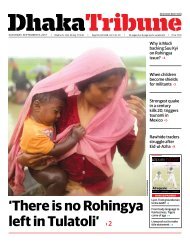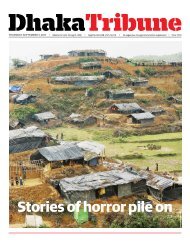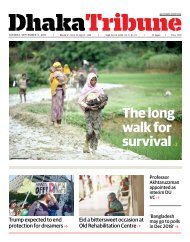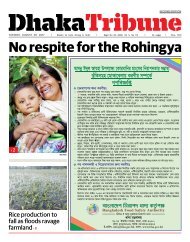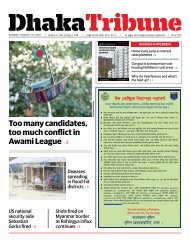e_Paper, Monday, May 15, 2017
Create successful ePaper yourself
Turn your PDF publications into a flip-book with our unique Google optimized e-Paper software.
2<br />
MONDAY, MAY <strong>15</strong>, <strong>2017</strong><br />
DT<br />
News<br />
Good or bad, all flows down to<br />
Intrusion of sand from unplanned mining in Meghalaya is leaving arable land barren and filling up Haor<br />
• Abu Siddique, back from<br />
Meghalaya, India<br />
Sand and stone chips dumped<br />
from unplanned mining operations<br />
in the Indian state of Meghalaya<br />
are being flushed downstream to<br />
Bangladesh, affecting arable land<br />
and decreasing the depths of the<br />
Haor basins. This in turn is making<br />
the northeastern region vulnerable<br />
to flash-floods.<br />
According to the Department<br />
of Agricultural Extension’s Sunamganj<br />
district office, around 120<br />
hectares of arable land has been<br />
covered by sand in Tahirpur upazila<br />
over the last decade, turning it<br />
completely barren.<br />
“And this is only in that specific<br />
area. If we look across the region,<br />
located south of the Megahlaya hills<br />
near the Bangladesh-India border,<br />
the damage is massive,” said Zahidul<br />
Haque, DAE deputy director.<br />
Andrew Sholomar from Rajai village<br />
in the upazila is one of the biggest<br />
victims of this sand intrusion.<br />
“I have already lost around <strong>15</strong><br />
acres of my 20 acres of land,” he<br />
told the Dhaka Tribune.<br />
If this cannot be stopped, his<br />
family might end up starving as it<br />
is dependent on that land, he said.<br />
The flow of sand and stone chips<br />
coming down with monsoon water<br />
has been decreasing the depths of<br />
the Haor basins, increasing the risk<br />
of flash-floods.<br />
Hydrologist Prof Ainun Nishat<br />
said although the flash-floods are<br />
a common phenomenon in the<br />
northeastern wetlands, there has<br />
been an increase in its frequency<br />
and magnitude.<br />
“Water usually carries sediment<br />
downstream. This is also true of<br />
the northeastern region,” he said.<br />
But the volume of sand intrusion<br />
with the water is alarming and need<br />
to be stopped at any cost, he added.<br />
Calling attention to several Beels<br />
– small water bodies – in Kharchar<br />
Haor in Sunamganj, the expert said<br />
many of them have already been<br />
filled up with sand.<br />
“The frequency and coverage of<br />
flash-floods have been increasing<br />
in the region as the beds of water<br />
bodies are gradually rising up,” said<br />
45-year-old Kamruzzaman Kamrul,<br />
chairman of Tahirpur Upazilla<br />
Parishad, who has lived in the area<br />
since his birth.<br />
What’s going on upstream<br />
Mineral resources including coal,<br />
limestone and stones are the biggest<br />
part of Meghalaya’s economy.<br />
The mining mostly takes place in<br />
three regions of the state – East Khasi<br />
Hills, West Khasi Hills and Garo Hills<br />
– all of which border Bangladesh.<br />
Sources in Meghalaya say the<br />
state government has relatively little<br />
control over the mining industry<br />
in these autonomous regions.<br />
According to the sources, there are<br />
around 1,000 operational mines in<br />
those three areas, all privately run.<br />
Altrisha Lyndoh, owner of a coal<br />
mine in West Khasi hills, told the<br />
Dhaka Tribune: “We have been doing<br />
this mining business in our own<br />
land. We dig the land, extract coal<br />
and sell it.”<br />
Asked whether she knows about<br />
the impacts of coal mining downstream,<br />
she said: “I have no idea.”<br />
HJ Syiemlieh, a professor of geography<br />
at the North Eastern Hill<br />
University in Shillong, told the Dhaka<br />
Tribune: “To extract coal, primarily<br />
the miners cut down forests and<br />
open pits, which ultimately makes<br />
the topsoil unstable and lets it wash<br />
downhill with monsoon water.”<br />
In 20<strong>15</strong>, the Indian National<br />
Green Tribunal, a government<br />
body, issued a ruling to stop unplanned<br />
coal mining in Meghalaya,<br />
saying it was destroying the topsoil<br />
and the local ecology.<br />
But the professor said as there is<br />
no strong government control over<br />
the issue, many mines have continued<br />
to run their operations in an<br />
unplanned manner.<br />
A fateful day<br />
Sand intrusion from Meghalaya has<br />
gone up sharply since 2008 when a<br />
sudden landslide in the West Khasi<br />
Hills of Meghalaya near the Bangladesh-India<br />
border sent a massive<br />
volume of sand down to Bangladesh.<br />
The incident destroyed around<br />
50 acres of land within minutes.<br />
“Within a few minutes, the nearby<br />
ponds and wetlands filled up<br />
How mining in India affects Bangladesh downstream<br />
Talking about how mining in India affects downstream Bangladesh with toxic water, HJ Syiemlieh,<br />
head of the Department of Geography at North Eastern Hill University, Meghalaya, speaks to the<br />
Dhaka Tribune’s Abu Siddique on the varied environmental impacts of this industry<br />
Tell us about the history of mining<br />
in Meghalaya.<br />
It began with limestone mining<br />
long before the British Raj came to<br />
this subcontinent. You can still see<br />
houses made of bricks and lime in<br />
Bangladesh and Calcutta that dates<br />
back to that period.<br />
When was coal introduced to the<br />
mining industry?<br />
The British began to the exact coal<br />
in this region when they arrived<br />
from Cherrapunjee side till about<br />
1969. Then moved their mining<br />
across the hills to Assam.<br />
Is there an environmental impact<br />
of mining?<br />
There is an environmental impact<br />
nationally. Mining waste especially<br />
coal mining waste is highly toxic.<br />
During the monsoon this toxic<br />
waste gets washed up and ends up<br />
in the river.<br />
In addition, the mining needs<br />
large parts of the land to be deforested<br />
which is definitely a loss of<br />
biodiversity as well as a loss of top<br />
soil as it gets washed away with the<br />
monsoon rain.<br />
Is the mining in Meghalaya<br />
including coal, limestone and<br />
other mineral resources currently<br />
controlled by the government or<br />
by the people themselves?<br />
The big issue is, the land belongs to<br />
the community. The government<br />
has no land. That’s why the individuals<br />
are mining their land rich<br />
with mineral resources.<br />
That means all the mining is<br />
controlled by locals and the<br />
government has no control over it?<br />
Something like that. The government<br />
does have control to some<br />
extent but it’s limited. Now with the<br />
National Green Tribunal (NGT), they<br />
have regulated the entire industry.<br />
And most probably this means mining<br />
will reduce in the area.<br />
Three districts—East Khashi Hills,<br />
West Khasi Hills and Garo Hills<br />
have autonomous bodies. Can the<br />
NGT issued rule govern over them<br />
to stop mining?<br />
In some sense they are autonomous<br />
district offices but the NGT<br />
has been governing over their activites<br />
in recent years.<br />
If the mining is mostly controlled<br />
by the locals, then how does the<br />
government plan to mine uranium<br />
here?<br />
There is huge opposition about the<br />
government’s plans to mine uranium<br />
here. If the government really<br />
wants to extract uranium then<br />
they would have to buy the land<br />
from the people first. But as far as<br />
I know, this programme is still at a<br />
ABU SIDDIQUE<br />
conceptual stage. Back in the 90s<br />
the government had identified certain<br />
uranium rich areas and wanted<br />
to mine them.<br />
The mining in Meghalaya causes<br />
dregs mostly sand, coal and stone<br />
chips to wash downstream into<br />
Bangladesh that ends up covering<br />
large areas of agricultural lands. Do<br />
you think there is a way to stop this<br />
process?<br />
I believe human activity does have<br />
an adverse effect on nature which<br />
needs to be contained as much as<br />
possible. There needs to be a way<br />
to stop this down stream sedimentation<br />
of mining dregs that the government<br />
of both India and Bangladesh<br />
need to find a mutual solution<br />
to.<br />
There was some recent reports by<br />
the Megahlayan media that a large<br />
number of fishes have been dying<br />
caused by the mining in the region.<br />
Similar kinds of things were<br />
reported in a Bangladeshi media<br />
recently as well, claiming a large<br />
number of fishes died in the Haor<br />
region because of radiation from<br />
uranium mining in India. What do<br />
you make of this claim?<br />
In the case of the fish dying in<br />
Meghalaya, I am not convinced it<br />
was caused by mining. In regards<br />
to uranium radiation, how is this<br />
going to kill fish if there is no uranium<br />
mines here in the first place?<br />
If uranium mining starts in<br />
Meghalaya in the future, do<br />
you not think this will impact<br />
Bangladesh downstream?<br />
Uranium mining will be a problem<br />
not only for Bangladesh but also<br />
for Megahalaya itself. It all depends<br />
on how the extraction is manage,<br />
mined and preserved. We have<br />
been asking the government exactly<br />
this as most people are extremely<br />
concerned about this.<br />
The government should use cutting<br />
edge technology that will not<br />
negatively impact the water, fishes,<br />
trees and land -as all of them are interrelated.<br />
•




